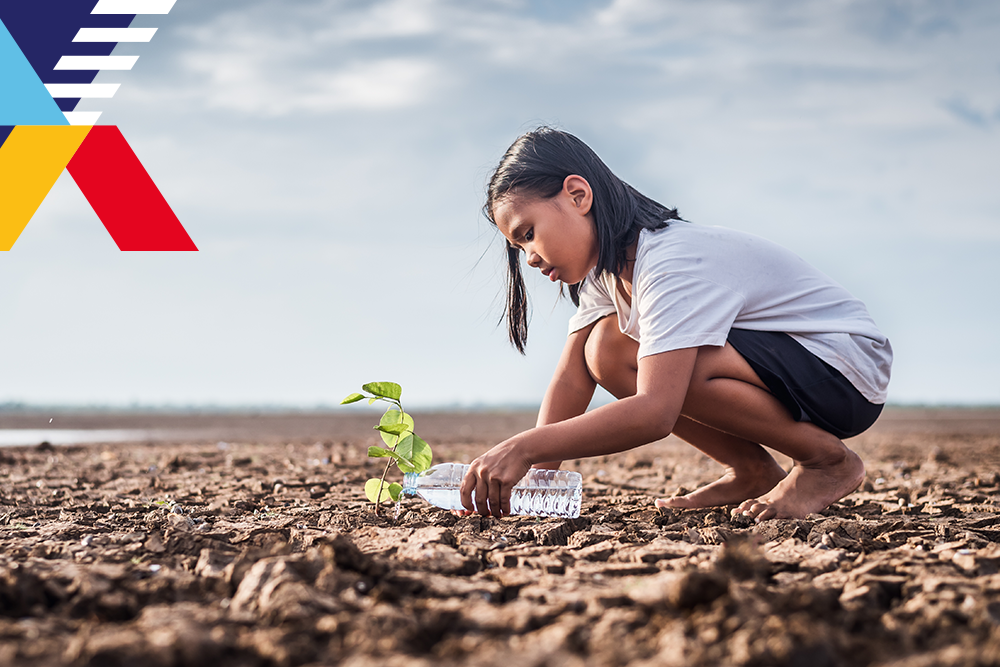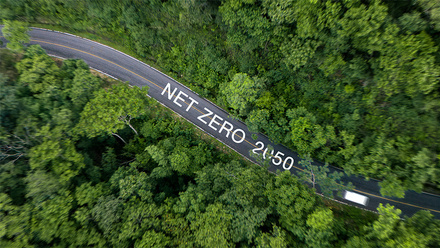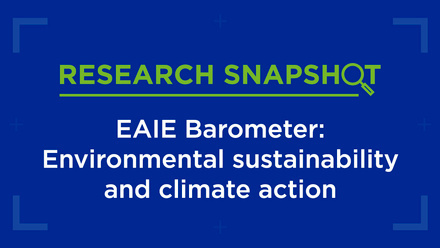Taking action towards ecosystem restoration

Of all today’s challenges that demand bold, brave action, climate change may be the most daunting. In the lead up to the 2021 EAIE Community Exchange, the Conversation Starter series asks us to contemplate how international higher education can respond to the pressing issues of our time. Today’s essay looks at the urgent need for restoring Earth’s ailing ecosystems, calling upon higher education institutions to join hands with youth networks dedicated to reversing the effects of climate change.
In recent years, the Youth Environmental Movement has grown in numbers, strength and determination to change our relationship with the planet for the better. As young people, we have a unique perspective on long-term issues. Decision-makers failing to address the climate and biodiversity crises right now only means that the problem is allocated further down the line.
For this reason, young people all over the world are taking a stance for the health of the planet and its people. This is the spirit in which Generation Climate Europe (GCE) was created. GCE is the largest coalition of youth-led networks at the European level, pushing for stronger action from the EU on climate and environmental issues. GCE brings together 460 national organisations across 47 countries in Europe. We are guided by the voices of 20 million young Europeans demanding that we restore our planet.
The need for ecosystem restoration
Ecosystem restoration refers to any activity that aims to aid the recovery of an ecosystem through repairing its structure and function and bringing it back to a healthy state. Importantly, by focusing on the notions of repair and restoration, this phrase goes beyond simply reducing damage to the environment. According to the Living Planet Report 2020, “Nature is declining globally at rates unprecedented in millions of years. The way we produce and consume food and energy, and the blatant disregard for the environment entrenched in our current economic model, has pushed the natural world to its limits. The damage caused to ecosystems is so severe that only protecting healthy ones would not be sufficient to deal with the climate and biodiversity crises’’ (WWF, 2020). Losing ecosystems means that we lose the functions they perform, such as providing habitats for wildlife to thrive, carbon dioxide absorption and climate regulation, flood protection, filtration of water, nutrient cycling and many other such activities vital to the planet’s health.
Such functions are essential for us to thrive and survive, and – in addition to their importance to our physical environments – also play a huge role in the global economy. The cost of inaction is far greater than the cost of action, and that is a big concern for young people. The longer we avoid addressing the crisis, the more consequences we will suffer. Recognising the responsibility that decision-makers have towards future generations is pivotal to steering policy and action. Restoration is a long-term process and it needs to begin now to ensure that we make progress towards intergenerational justice. In addition, it is essential that young people are given opportunities to be involved in, and supported by, restoration efforts.
Recognising the responsibility that decision-makers have towards future generations is pivotal to steering policy and action
Even though financial considerations are important, they push us to regard nature through the capitalistic lens that caused the problem in the first place. The intrinsic value of nature has to be rediscovered for real restoration to occur.
In 2020, the deadlines for many long-term environmental goals passed, and yet again, we are left with unfulfilled promises and missed targets. The level of ambition shown by decision-makers, especially in Europe, has not been backed by tangible action, leading to ever-increasing degradation of the planet. The current pandemic is yet another illustration of our impact on the Earth’s systems. According to the IPBES Pandemics Report, “the underlying causes of pandemics are the same global environmental changes that drive biodiversity loss and climate change’’ (IPBES, 2020, p.2).
Where are we headed and why?
Ecosystem restoration is becoming more prevalent in the global agenda, yet young people are weary of ambitious targets. In 2019, at the General Assembly of the United Nations, El Salvador’s Environment Minister proposed devoting the next decade to ecosystem restoration. The proposal was accepted and the Decade of Ecosystem Restoration now runs from 2021 to 2030, in line with the Sustainable Development Goals. As stated on the official UN website, “[it] aims to prevent, halt and reverse the degradation of ecosystems on every continent and in every ocean”, a very ambitious plan to reverse current trends on climate change and ecosystem degradation, while also trying to lift people from poverty.
Although financial considerations are important, they push us to regard nature through the capitalistic lens that caused the problem in the first place
So, where does Europe stand on ecosystem restoration? A study conducted in 2019 showed that, on average, €124.8m was allocated to ecosystem restoration in Europe by the EU, specifically thanks to the LIFE+ budget in 2007–2013, every year since 2010 (UNEP-WCMC, FFI and ELP, 2020, p.16–20). Although this sum looks massive, it is important to note that funding has been reduced since 2014 and that it is far from being evenly distributed across all countries and ecosystems. For instance, countries in Eastern Europe received much less funding than countries in Western Europe. In addition, terrestrial ecosystems in Europe receive far more funding than marine ecosystems, leaving these very crucial ecosystems underfunded in the European context. It is also important to look at how the EU is allocating the rest of its budget. For instance, the Common Agricultural Policy (CAP) has received a total of €386.6 billion (European Commission, 2021), all the while being harshly criticised for its inability to protect farmland biodiversity (Kelleher, 2020) and contributing to the continuous loss of biodiversity around Europe, showing discrepancies within the EU agenda and proving a lack of commitment to the protection of ecosystems.
It is refreshing to see that, after being disregarded for so long, ecosystem restoration is finding its place within the global and European policy sphere. However, it is also important to keep a critical eye on some projects. Ecosystem restoration has a long history of being used as a tool against Indigenous populations or local communities. For example, states introduce protections on some lands in order to preserve them; in doing so, however, they force their inhabitants out. Part of creating a real paradigm shift in the way we address our relationship with nature is recognising the different actors involved and how different techniques and practices can be inclusive. It does not only mean reconnecting with nature, but also addressing underlying issues and inequalities within our society and mending them through a larger understanding of what nature is and means for all of us.
The role of (international) higher education
Although ecosystem restoration may seem like a niche topic to address, and one that not many can have a say in, everyone can contribute to a better relationship with nature. Being a part and following the lead of Green Erasmus and many other projects around Europe striving to make education not only excellent but also sustainability-oriented is also an important step to take.
Green Erasmus and many other projects around Europe are striving to make education not only excellent but also sustainability-oriented
For instance, as international education professionals and members of higher education institutions, one could consider financing a youth group or a student group that is committed to biodiversity protection and ecosystem restoration. Other key supports include giving official and formal platforms for these groups to be heard on campus and to be involved in key discussions at an institutional level; often, such involvement is a struggle for youth and student groups to achieve independently. It is also useful to research organisations working on ecosystem restoration and support them. An example of this work at a European level is Generation Climate Europe, which brings together volunteers from across Europe working collectively for a better world, giving young people responsibility and a platform from which to be heard. GCE and other organisations like it, working in tandem with higher education institutions and other stakeholders committed to the future of the planet, are vital in the process of enabling students and young people in Europe to be bold, brave and effective in their battles for sustainability.
Questions for further discussion
1. Are you aware of initiatives of ecosystem restoration in the community where your higher education institution is based?
2. Is your institution directly involved in initiatives of ecosystem restoration, or in research on it?
3. How can international higher education institutions join forces to step up the efforts towards ecosystem restoration?
References
European Commission. (2021). Common agricultural policy funds. Retrieved from https://ec.europa.eu/info/food-farming-fisheries/key-policies/common-agricultural-policy/financing-cap/cap-funds_en
IPBES. (2020). Workshop report on IPBES workshop on biodiversity and pandemics. Bonn, Germany: IPBES. Retrieved from https://ipbes.net/sites/default/files/2020-12/IPBES%20Workshop%20on%20Biodiversity%20and%20Pandemics%20Report_0.pdf
Kelleher, L. (2020, June 7). CAP: billions spent on biodiversity with little impact – auditors. Retrieved from https://www.arc2020.eu/cap-billions-spent-on-biodiversity-with-little-impact-auditors/
UNEP-WCMC, FFI and ELP. (2020). Funding ecosystem restoration in Europe: a summary of funding trends and recommendations to inform practitioners, policymakers and funders. Retrieved from https://restorationfunders.com/funding-ecosystem-restoration-in-europe.pdf
WWF. (2020). Living planet report 2020 – bending the curve of biodiversity loss. Gland, Switzerland: WWF. Retrieved from https://f.hubspotusercontent20.net/hubfs/4783129/LPR/PDFs/ENGLISH-FULL.pdf






